THE ERITREAN
RAILWAY PHOENIX
by M.C. Cuningham
| In 1991, after many years of internal conflict, the Eritreans
were successful in their fight for independence from Ethiopia. One of the
major casualties of these troubled times was the
Eritrean Railway, which had ceased to operate around 1974. The new Eritrean Government has set up a "Railways Rehabilitation Project," headed by Mr. Amanoel Ghebreselassie, with the task of re-introducing a rail service between the port of Massawa, on the Red Sea, and the capital, Asmara, which is 117.6 km inland and 2,342 metres above sea level. A decision as to whether the 188.8 km extension from Asmara to Agordat will be repaired will be made after the Massawa to Asmara line has been reopened. HISTORY Eritrea was an Italian Colony and the Italians opened a 75 cm line from Massawa to the Fort of Sa'ati, some 24 kms inland in 1888. In 1900 it was decided to change the gauge to the Italian Standard Narrow Gauge of 95 cm and to extend the line up the escarpment to Asmara. The line reached Ghinda (69.45 km from Massawa) in 1904, but it took a further seven years to complete the 48.15 kms to Asmara. Another 11 years elapsed before the line arrived at Agordat in 1922. A further extension reached the town of Biscia in 1925, with the intention of extending from there to meet the 3'6" gauge Sudan Railway at Tessenai. This last extension was never built, and the British removed the track from the Agordat-Biscia extension in 1941 to use in their North African campaign. |
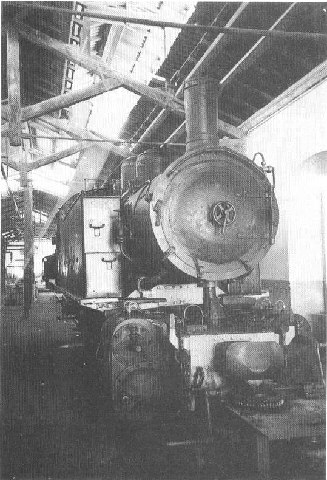
0-4-4-OT A'o. 442-55 in Asmara steam shed, 25th October 1997. Photo: M.C. Cuningham
|
| DESCRIPTION OF THE LINE
The Massawa to Asmara line is one of the great railway engineering feats of the world. There are few lines that climb to a summit of 2,394 metres in just 115 km. From Massawa to Mai Atal (Km 29.4) the gradient is fairly easy, however, from here to Damas (Km 45) there is a "hump" which necessitated trains being split at Mai Atal. The line then steepens towards Ghinda (Km 69.4) with a maximum grade of 3% with 100 metres uncompensated minimum radius curves. From Ghinda to Asmara the maximum gradient increases to 3½% with uncompensated 70 metre minimum radius curves. The maximum load which could be taken by the 'big' 442 Class Mallets over this section was 90 tons, while the Krupp Bo-Bo Diesels were limited to 100 tons – half the allowed load between Massawa and Mai Atal. |
There are 30 tunnels and 35 bridges
between Massawa and Asmara, most of the tunnels being on the Ghinda to
Asmara section, ranging in length from 372 to 35 metres. These tunnels
and bridges are all in remarkably good condition, except for the railway
bridge over the Massawa to Asmara main road near Nefasit, which needs new
girders and, possibly, raising to allow large modern lorries to pass
underneath. There were13 stations on this line.
From Asmara (2342 metres) the line descends to Agordat (606 metres) some 188.8 km distant. The main intermediate station is at Keren, 104 km from Asmara. The maximum gradient on this line is 2½%, with minimum radius curves of 100 metres. There were 17 stations on this line, 9 tunnels and 30 bridges. The track bed is in a similar state to that of the Massawa line. The fine station building and yard at Keren are now given over to buses. |
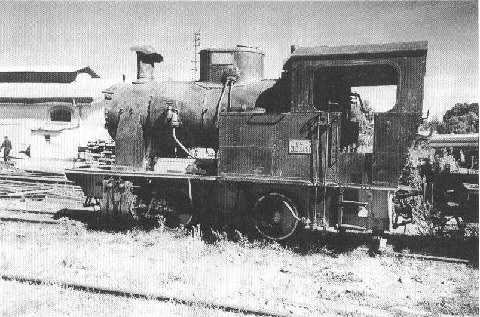 |
0-4-0T No. 202-008 in working
order outside Asmara steam shed, 28th October 1997.
Photo: M.C. Cuningham
|
| PRESENT SITUATION.
The Station, locomotive sheds, workshops and yards in Asmara are largely intact, although cut off at present from the rest of the system. Also, during the interim period, the quasi-government "Transhorn" Transportation Company has taken over many of these buildings for its own purposes. The Railway would like to get them back. Nevertheless, despite these problems, the Railway has brought hree steam engines (2 x 0-4-4-0T and an 0-4-0T), two Bo-Bo diesels, a small shunting diesel and two rail-lorries into operablecondition, together with some permanent way equipment. The workshops are also producing items for the civil engineering side. Full details of the present locomotive fleet are shown in the appendix. The few surviving Railway Coaches are at present occupied by squatters. There are well over 100 freight vans and wagons |
extant, of which about 20 had been refurbished by October 1997.
Massawa Station, now given over to housing and a clinic, is situated on Tallud Island. The station yard contains a number of rusting sidings and one or two rotting vans, all very desolate. From here, a very rusty and, in some parts, missing line extends north over a causeway to Port Island, where the line disappears into the docks. Just outside the dock gates is a shelter from which the passenger trains to Asmara used to start. It is now a bus and taxi terminus. Just south of Massawa Station, the line is cut by a huge new building
under construction. It is not clear if the line will be able to by-pass
this or if a new terminus will have to be built on its southern side. At
present, the rehabilitated line starts here with a simple run-round loop
in the middle of a Container storage yard. From Tallud Island the line
continues across a causeway to the mainland and is now largely ready for
use as far as Mai Atal, a distance of 29 km.
|
| Old wagons (with provision for the
brakesman) in Asmara station yard. |
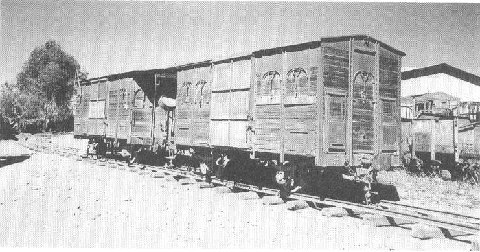 |
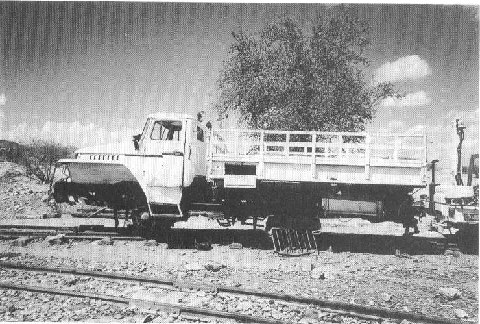 |
An 'Orion' rail-lorry at Mai Ata! for
permanent way duties, 30th Oct 1997 |
| A motorised inspection trolley at Mai Atal.
All photos: M..C. Cuningham.
|
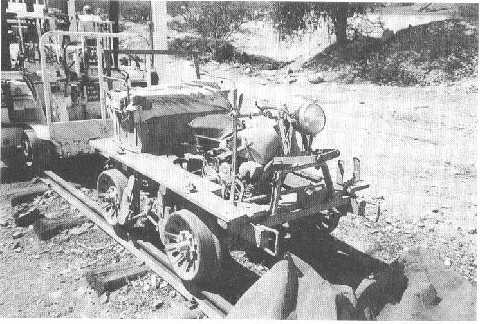 |
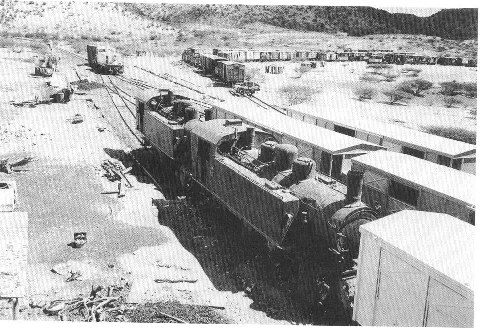
Looking out from the station balcony at Mai Atal we see Mallet 0-4-4-0T Nos. 442-54 and 442-59 in the company of refurbished box vans, and in the background Krupp diesel 25D in white livery, with sidings of old freight wagons curving away into the distance.
| Mai Atal Station has been refurbished and is being used as a base for
relaying the track and other associated civil engineering projects. Most
of the line's rails and metal sleepers were torn upand used for military
or other purposes during the war. Luckily, it has proved possible to recover
sufficient to relay the line - the major cause of delay being the late
arrival of a stone crushing machine ordered from the U.K. The Railway
is at present unable to obtain sufficient ballast to keep the two tamping
machines fully occupied. Nonetheless, work on the line from here to Ghinda
(69.4 km) is proceeding apace, helped by the fact that, as parts of this
section are very remote, some of the rails are still in situ. 1t is hoped
that this section will be completed by April this year.
A commuter service across the causeway from Massawa's Tallud Island to the mainland was introduced using two low sided wagons (provided with wooden seats and canopies) and an 0-4-0DM locomotive, however, this engine proved unreliable and the service has been suspended. The locomotive is thereforebeing re-engined. Once the Massawa to Ghinda Section is ready, it is intended to operate
a railcar service over this line. To this end 4 or 5 Railcars will be purchased,
as it is thought that the two existing pre-war railcars (Littorinas) should
only be used for tourist services. The railcar service will be extended
as and when the next sections of the line are ready for use
|
It is also hoped to introduce freight services, using the two Krupp
Bo-Bo diesels for this purpose. If the considerable container traffic could
be diverted to the railway, this would provide a solid financial base upon
which to build other services.It is envisaged that, while the steam engines
will provide a back-up to the diesels, their main role will be to power
tourist trains.
It should be mentioned that the Government considers this to be a prestige project, not only to improve the country's transport infrastructure, but also for heritage reasons. As an indication of this they have even gone so far as to put a picture of one of the "Orion" lorries pulling a rake of wagons on the new 10 Nafka bank note. All going well, the line between Massawa and Asmara will be completely
rehabilitated within the next two years or so, and I, for one, will then
return for a ride behind steam up this most spectacular of lines.
BIBLIOGRAPHY
|
| Engine No | Wheel Arrangement | Maker | Works Plate Carried | Original Works No | Present State | Location | Remarks |
| 202-002 | 0-4-0 T | Breda | 2169/27 | 2169/27 | Stored | Asmara | Shunting Engine |
| 202-004 | 0-4-0 T | Breda | 2454/37 | 2272/29 | Under Repair | Asmara | Shunting Engine |
| 202-008 | 0-4-0 T | Breda | 2272/29 | 2454/37 | Working Order | Asmara | Shunting Engine |
| 202-009 | 0-4-0 T | Breda | No Plate | 2455/37 | Stored | Asmara | Shunting Engine |
| 202-010 | 0-4-0 T | Breda | 2456/37 | 2456/37 | Stored | Asmara | Shunting Engine |
| 202-011 | 0-4-0 T | Breda | 2457/37 | 2457/37 | Stored | Asmara | Shunting Engine |
| 440-008 | 0-4-4-0 T | Ansaldo | No Plate | 1162/15 | Stored | Asmara | Line Engine |
| 442-54 | 0-4-4-0 T | Ansaldo | 1363/38 | 1364/38 | Working Order | Mai Atal | Line Engine |
| 442-55 | 0-4-4-0 T | Ansaldo | 1370/38 | 1365/38 | Repairs almost completed | Asmara | Line Engine |
| 442-56 | 0-4-4-0 T | Ansaldo | 1367/38 | 1366/38 | Stored | Asmara | Line Engine |
| 442-57 | 0-4-4-0 T | Ansaldo | 1369/38 | 1369/38 | Working Order | Mai Atal | Line Engine |
Diesel Locomotives
| 25 D | Bo-Bo | Krupp | 3601/57 | ? | Working Order | Asmara | Line Engine |
| 27 D | Bo-Bo | Krupp | 3602/57 | ? | Working Order | Line Engine | |
| ? | 0-6-0 | Drewry | 2075/36 | ? | Under Repair | Asmara | - |
| ? | 0-6-0 | Drewry | 2078/37 | ? | Working Order | Asmara | Original Gardner engine repaired by Fiat |
| ? | 0-4-0 | Drewry | 2078/38 | ? | Under Repair | Asmara | Recently used on commuter train at Massawa |
| 2 | 2 x 4-wheel bogie | Fiat | – /1935 | ? | Under Repair | Asmara | For Tourist Specials |
| 7 | 2 x 4-wheel bogie | Fiat | - /1936 | ? | Working Order | Asmara | For Tourist Specials |
| 2 | 2 x 4-wheel bogie | Fiat | - | ? | Stored | Asmara | Small railcar |
| - | Bo | Brown Boveri | 4067/35 | 4067/35 | Abandoned | Off rails at Mai Atal | Formerly on the Italian Somaliland Railway |
Rail-Lorries ('Orions')
| No number | 4-wheel | Orion (?) | Working order | Mai Ata | Permanent Way | ||
| 4-wheel | Orion (?) | Working order | Mai Ata | Permanent Way |
The above material came from Locomotives International Issue 43.
It is posted with permission of both the Author and the Publisher.
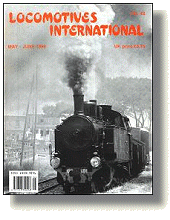

Home |

Scrapbook |
| Who | What | Why | When | Where |